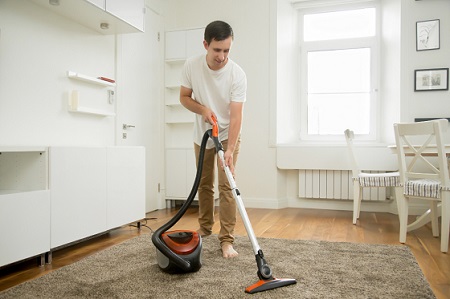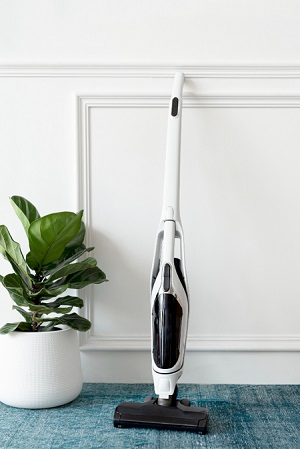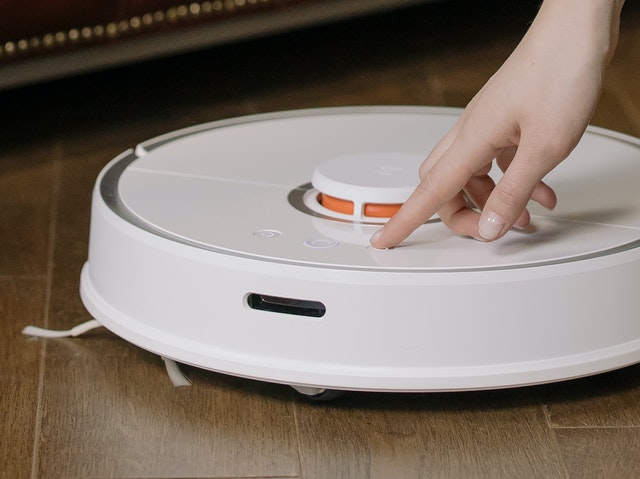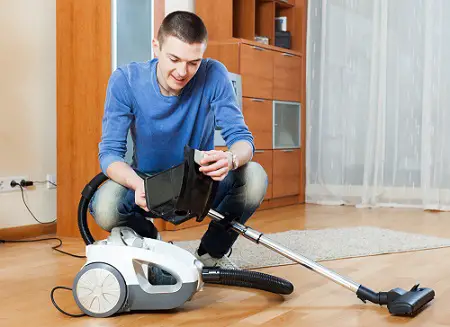Imagine a world without vacuum cleaners: dusty carpets, dirty floors, and a constant battle with crumbs and pet hair. Fortunately, these faithful household allies are here to make our lives easier. But like any hero, vacuum cleaners also have their Achilles heels. In this article we will see The Most Common Problems Vacuum Cleaners Face, whether with regard to canister vacuum cleaners, stick vacuum cleaners to robot vacuum cleaners and, for each problem, we will provide you with effective solutions.
1. Problems with canister vacuum cleaners

In the family of vacuum cleaners, canister vacuum cleaners are the oldest. They're simple, sturdy, designed for a variety of surfaces, and packed with remarkable suction power. Their biggest weaknesses: their lack of practicality and their bulk. But despite everything, they still have their place in many homes because they are little gems in terms of reliability. In fact, they are practically indestructible. Here is the few possible faults encountered on canister vacuum cleaners :
Problem 1: Loss of power and suction
The number 1 problem I've noticed with canister vacuums is that they eventually lose suction power as it is used. And it’s a shame when we know that this is their primary function. Several causes and therefore several solutions can be at the origin of this problem.
To start, check that the bag is not full or the filter is not clogged. This is because over time, bags and filters can become clogged with dust and debris, reducing vacuuming efficiency. Replace the bag if it is full and clean or replace the filter according to the manufacturer's recommendations.
It may also be that larger objects or clumps of dirt block the pipe. In this case, unplug the vacuum cleaner and inspect the hose. Use a long, flexible object to dislodge any blockages.
Finally, very often, it can happen that the brush is cluttered. This is because hair, pet hair, textile fibers or other debris can accumulate around the brush, limiting its movement and suction efficiency. Carefully remove hair and fibers wrapped around the brush. To prevent the problem from recurring, clean it regularly.
Problem 2: Excessive noise
A particularly disturbing and yet very common problem with canister vacuum cleaners is their excessive noise. If the noise produced by the vacuum cleaner increases in decibel over time or changes and becomes unpleasant (hissing, growling, etc.), here is where it can come from and what to do to try to reduce the sound volume:
To start, check the interior and the brush of the device and clean out any clumps of dust or debris because if they get stuck in it, they can cause excessive noise.
If unfortunately this does not solve the problem, the noise is certainly coming from component wear. These could be loose components from constant vibration. In this case, turn off the device and inspect the internal components if you can open it. Tighten screws and fasteners if necessary.
An unusual noise could also be a problem with the motor, especially if the vacuum cleaner is making a loud noise. squeak or slam. In this case, I advise you to have it examined by a professional.
2. Problems with stick vacuum cleaners
Stick vacuum cleaners are known for their lightweight, maneuverability and sleek design, making them preferred options for quick and efficient cleaning. However, despite their many advantages, stick vacuum cleaners are not immune to breakdowns. From managing battery life to limited suction power to specific mechanical issues, learn common problems faced by stick vacuum cleaners :
Problem 1: Battery Malfunction
The most common problem I've seen with stick vacuums is the battery.. Several problems exist and each problem will have its specific solution:
The battery doesn't last as long as before :
All vacuum cleaner batteries have a limited number of charge cycles. Over time, the battery capacity of a stick vacuum decreases, reducing its autonomy and power. To resolve this problem, the solution is simply to replace the battery.
To do this, identify the type of battery needed and obtain a replacement battery from the manufacturer or a reliable supplier. Follow the instructions in the manual to safely replace the battery.
Note that some batteries are not intended to be replaced. In this case, you will need to contact the manufacturer's after-sales service or a professional repairer.
Maintenance Tips : To extend battery life, avoid completely discharging the battery before recharging. If the vacuum cleaner is not used for an extended period of time, charge the battery to approximately 80% to maintain its health.
Battery that no longer charges or no longer charges properly :
This problem occurs on all brands of vacuum cleaners (Honey, iRobot, Hoover, Samsung, Rowenta, etc.), To resolve this malfunction, make sure that the charger is correctly connected to the vacuum cleaner and to a working electrical outlet, without a power strip or extension cord. Also check for signs of damage to the cable or adapter. If in doubt, replace it.
Charge the vacuum for as long as necessary to charge it until it reaches its maximum capacity (usually several hours).
Please note, to avoid this problem in the future:
- Do not leave the vacuum cleaner plugged into the charger once the battery is fully charged. This can lead to overloading, or in the event of a power outage, to damage to its internal components.
- Using the vacuum cleaner regularly helps keep the battery in good condition.
- Avoid storing the vacuum cleaner in extremely hot or cold environments, as this may affect battery performance.
Read also: My Dyson stick vacuum no longer charges, what should I do?
Problem 2: The stick vacuum no longer sucks or has difficulty vacuuming

Your upright vacuum cleaner no longer sucks or the suction power has significantly decreased over time? This problem, directly impacting cleaning efficiency, can be caused by several factors. It can occur on all brands of vacuum cleaners, but two famous ones are particularly affected: Bosch et Dyson.
Let's take a closer look at these causes and discover suitable solutions:
Usually the problem is simply one or more clogged filters. Indeed, over time, filters can become clogged with dust, dirt, hair, pet hair and other particles, which can obstruct the air passage and decrease the power of the filter. aspiration.
For washable filters, remove them and wash them according to the manufacturer's instructions. Let them dry completely before putting them back in place. If the filters are not washable or damaged, replace them. Note that, most of the time, manufacturers recommend checking the filter every 3 to 6 months, depending on usage.
If the problem is not with the filters, then check the air ducts. Debris such as hair, pet hair, and large pieces of dirt can build up in the air duct, preventing optimal airflow. Unplug the unit and visually inspect the air duct. Use a thin tool to gently dislodge obstructions without damaging the duct.
In case the problem persists, there may be air leaks in the suction system, often due to worn seals or cracks in the pipes, which can then reduce suction power. Then carefully examine the pipes and joints for signs of wear or damage. Also listen for hissing sounds that could indicate a leak.
Problem 3: Stuck rotating brush
Finally, it often happens that the rotating brush of the broom vacuum cleaner gets blocked by hair, fibers, or other debris, reducing its effectiveness or preventing it from spinning.
To resolve this, turn off and unplug the vacuum cleaner. Remove the rotating brush and use tweezers to gently remove any hair or fibers wrapped around the spindle. Next, clean the brush with a soft brush to remove any remaining debris. Finally, make sure the brush is properly aligned and reassembled according to the manufacturer's instructions.
3. Problems with robot vacuum cleaners

Robot vacuum cleaners and their ability to clean autonomously represent a leap forward in the field of housekeeping. However, despite their practicality, like any technologically sophisticated device, they can encounter malfunctions. But then, What are the common problems with robot vacuum cleaners and what solutions exist to repair them?
Problem 1: Uncontrollable or haphazard navigation
Robot vacuums rely heavily on their navigation system to move efficiently through a space. When this system is compromised, it can result in erratic or uncontrollable browsing, where the vacuum cleaner seems disoriented or unable to follow a logical path. So, here are the solutions to maintain the cleaning efficiency of the device:
The first thing to do is to check that its sensors are not dirty. Indeed, the vacuum cleaner's sensors, such as collision, vacuum, and optical sensors, play an essential role in navigation. When they are dirty or damaged, they cannot function properly, leading to inaccurate navigation.
To gently clean the sensors, use a soft, dry cloth. Avoid liquid cleaning products that could damage electronic components. Then inspect the sensors for any visible cracks or damage. If a sensor appears damaged, then you can contact customer service for repair or replacement.
If this does not allow your robot vacuum cleaner to resume its normal trajectory, note that a cluttered environment or the presence of reflective objects can also disrupt the vacuum cleaner's sensors. Move bulky objects or small objects that could disrupt its trajectory. Make sure the space is as clear as possible. Since highly reflective surfaces can interfere with optical sensors, also consider covering or modifying these surfaces if they are a problem.
If this still does not resolve the problem, a simple restart can resolve temporary software issues. Turn off the device, wait a few minutes, then turn it back on.
Then try to update it because outdated software can cause malfunctions in the vacuum cleaner's navigation system. To update it, make sure your vacuum cleaner is connected to your home Wi-Fi network. Then check on the app if an update is available. Remember to regularly check for updates via the application associated with the vacuum cleaner or on the manufacturer's website to prevent problems from occurring.
reset the robot vacuum, and restart a mapping session and reprogramming.
Problem 2: Robot vacuum cleaner does not return to charging base
One of the most convenient aspects of robot vacuums is their ability to automatically return to their charging base after completing their cleaning task. However, Sometimes robots have difficulty locating or reaching their charging station. This problem can be caused by several factors. Here's how to fix the problem:
- Clear the Path: Make sure there are no objects, furniture or electrical wires in the way between the vacuum cleaner and its base. Avoid leaving objects lying around on the floor that could be moved by the vacuum cleaner as it cleans, thus blocking its return.
- Check that the base is correctly positioned : If the charging base is not in the usual place or in the wrong direction, the vacuum cleaner may have difficulty locating it. Place the base in an open area, on a flat, hard floor, and away from sources of heat or direct light.
- Check the location around the base: Make sure there is enough space around the base for the robot vacuum to approach and connect easily.
- Check the battery status : An overly discharged battery may prevent the vacuum cleaner from returning to its charging base. Monitor battery levels and make sure the vacuum begins its cleaning cycle with a full charge. If the vacuum cleaner battery loses its charge quickly or does not charge fully, I recommend replacing it.
- Complete reboot of devices : Turn off the vacuum cleaner and the charging base, wait a few minutes, then turn them back on to reset their connection.
- Communication issues: Signal or communication issues between the vacuum and its base may interfere with automatic return. If the vacuum uses Wi-Fi for communication with the base, make sure the Wi-Fi signal is strong and stable in the area where the base is located.
Finally, if nothing helps and your robot vacuum cleaner still refuses to return to the charging base, reset the device before reprogramming it.
Problem 3: Ineffective cleaning performance
One of the main advantages of robot vacuum cleaners is their ability to clean autonomously. However, whenthey do not clean effectively, this can be both annoying and counterproductive. Here's how to try to resolve this issue:
- Check the dust bin. A full dust bin or clogged filter can limit the vacuum's ability to pick up dirt and dust. Check and empty the dust bin after each use or more frequently if necessary. Also remember to clean it regularly following the manufacturer's cleaning precautions.
- Clean or replace filters according to the manufacturer's instructions. Some filters can be washed, while others need to be replaced periodically.
- Clean the brushes. Remove the brushes and use a cleaning tool (often included with the vacuum) to remove hair and debris. Indeed, hair, animal hair, textile fibers and other debris can accumulate on the vacuum cleaner's brushes and extractors, reducing their effectiveness. If the brushes are worn or damaged, I suggest replacing them to maintain optimal cleaning performance.
- Check the settings of the robot vacuum cleaner. Indeed, using settings not suited to the type of floor or the amount of dirt can affect cleaning performance. Use the app or the vacuum controls to select the most suitable cleaning mode for your environment (for example, intensive mode for carpets or gentle mode for hard floors).
Finally, if the previous easy solutions didn't work, check battery status. A battery that does not hold a charge can prevent the vacuum from completing its cleaning cycle. Then observe if the vacuum cleaner manages to complete its cleaning cycle. If the battery discharges too quickly, it may require replacement. In this case, consult the user manual or contact the manufacturer for instructions on replacing the battery.
Problem 4: Robot vacuum no longer charges
One of the most common problems I have noticed with robot vacuum cleaners is whenthey stop charging.
To begin with, the problem may come from a faulty connection to the charging station, which may prevent the robot vacuum cleaner from recharging. Then start by cleaning the charging contacts on the vacuum and the dock with a soft, dry cloth to remove any accumulation of dust or debris. Check that the connectors are in good condition (not twisted, bent, burned, etc.). Then make sure the vacuum cleaner lines up correctly with the charging station. Adjust the position of the station if necessary.
Then, the station's charging cable may be damaged and prevent the vacuum cleaner from recharging. Check if there is any visible damage on the charging cable. Look for signs of cuts, severe bends or burns. If you notice any damage, replace the charging station cable. Caution, use only replacement parts approved by the manufacturer.
If nothing helps, a Software bug can sometimes cause charging issues, although this is less common. Then make sure that the robot vacuum cleaner is up to date with the latest software version. Check the associated app or manufacturer's website for updates. In some cases, completely resetting the vacuum cleaner may resolve the issue.
Finally, if the problem persists, the battery of the robot vacuum cleaner is certainly defective. Which is completely normal, since over time, the vacuum cleaner's battery deteriorates and loses its capacity. Problems then appear such as robot vacuum cleaner that no longer holds a charge or which no longer charges at all.
In this case, there is only one solution: replace the battery. Consult the user manual for specific instructions or contact the manufacturer's customer service.
Complete guide to common vacuum cleaner problems by brand
The performance and reliability of a vacuum cleaner can vary greatly depending on the make and model. In this part, we will see the most popular vacuum cleaner brands on the market, highlighting their distinctive characteristics as well as frequent problems which they face. So whether you own a Dyson, Rowenta, Samsung, or any other model, this guide will help you identify and resolve most of the common problems they face.
1.iRobot
The company iRobot, is his famous model Roomba, is the pioneer in the field of robot vacuum cleaners. These devices are known for their smart and reliable navigation technology and their ability to adapt to different home environments very easily.
Common Problems with Roomba Vacuums :
- Batteries that lose their charging capacity over time.
- Overnight startup problem.
- Sensors that require frequent cleaning to avoid navigation errors.
2. Philips
Philips, known for its wide range of electronic products and home appliances, offers vacuum cleaners known for their durability and innovation. The brand is rather famous for its ranges of canister vacuum cleaners, but it also markets stick vacuum cleaners and robot vacuum cleaners.
Common problems :
- Filters that become clogged quickly, requiring regular maintenance.
- Mechanical problems like blocked brushes or damaged wheels.
- Battery failure on robot vacuum cleaners that prevent them from starting.
3. Samsung
Samsung, a giant in electronics, offers vacuum cleaners with advanced technologies, including robot vacuum cleaners.
Frequent problems :
- Wi-Fi connectivity issues for robotic models.
- Battery or charging system failures.
4. Thomson
Thomson is known for offering home appliances at affordable prices. Their vacuum cleaners are appreciated for their good value for money.
Common problems :
- Rapid wear of mechanical parts in certain models which leads to malfunctions (vacuum cleaner that no longer works, which no longer starts, which has random navigation, etc.).
- Loss of suction power over time.
5. Honey
Miele is known for its high-end home appliances, including its canister, robot or broom vacuum cleaners, which are often praised for their performance and longevity.
Common problems :
- High cost of spare parts and accessories.
- In some cases, engine problems may occur resulting in suction problem or a starting fault.
6. Hoover
Hoover is a historic name in vacuum cleaners, offering a wide range of models, from traditional to modern.
Frequent problems :
- Frequent blockages due to accumulation of debris that can.
- Loss of suction power over time.
Read also: My Hoover vacuum cleaner won't turn on, what should I do?
7. Rowenta
Rowenta is known for its quality home appliances. The brand specializes in the manufacture of irons and vacuum cleaners. These models offer a good balance between performance and design.
Common problems :
- Filters requiring frequent cleaning resulting in suction problems.
- Battery durability issues in cordless models causing charging issues or even refusal to turn on once the battery is totally dead.
8 Bosch
Bosch offers a variety of home appliances, including canister and stick vacuums, known for their reliability and energy efficiency. The brand is particularly recognized for its durable and innovative batteries.
Frequent problems :
- False contact issues with certain electronic components in certain models causing its shutdown during use or a complete refusal to turn on.
- Despite its great reputation for manufacturing reliable batteries, some stick vacuums, like the Readyy'y Serie 2, are victims of failures on their battery (no longer holds the charge, no longer charge or even flashes red).
9. Dyson
Dyson is a very popular brand for its innovative and high-performance bagless stick vacuum cleaners, offering cutting-edge technology and unique design.
Common problems :
- High cost of spare parts.
- Battery issues in cordless models causing untimely cuts, ignition problems or even a loss of autonomy.
- Personalized bad smells from bagless vacuum cleaners.
Read also: My Dyson stick vacuum cleaner is flashing red, what should I do?

